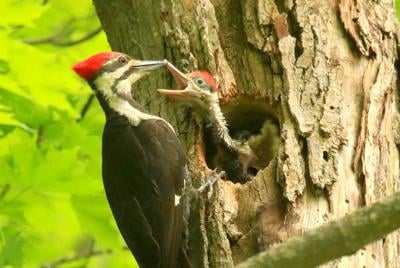They're not commonly seen birds but that's not because they're small. About the size of a crow, they're spread sparsely throughout mature woods and very secretive about their nest sites, cavities they carved into trees.
In the past I have gotten very few photos of the huge pileated woodpecker, so this “home” adventure has been really exciting for me.
My house is in mature woods (no lawn) and I always thought it was odd that I seldom see the pileated woodpecker around my woods. When I do get a glimpse of one, he's usually headed away. Then, one day this early spring I noticed a dead tree down the road that had a large area pecked out of it near the ground: A sure sign of returning woodpeckers.
A few weeks later I was startled a few times by one of these largest woodpeckers flying away from a big maple off my back porch. Then, a few times there were a pair of them screaming as they flew off the porch.
“Hey, Doug, maybe they are preparing a nesting hole!” I thought — and started to sneak out the back door to see if I could spot where they were coming from up in that big maple. It took a lot of looking, but sure enough I found a 3-1/2 inch hole facing my house. It was about 60 feet up in a dead section of the tree and was well camouflaged by leaves on nearby branches.
Walking around the tree I found a bunch of wood chips scattered on the ground, another good sign as pileated woodpeckers dig a large cavity in a tree — up to 2 feet deep — for nesting. They carve a new nesting hole each year and wood ducks often use woodpeckers' old, abandoned cavities for their nests, since the size is just right for them.
Now I was really excited. What good fortune to have this bird nesting less than 20 yards from my house! So I was careful not to use the back driveway by the tree or do any activities around that area. Soon I was not seeing the woodpeckers but I heard an occasional calling, which was a good sign. It meant one was incubating and the other was calling to signal it was ready for its turn to sit on the eggs while the incubating one went out for exercise and a bite to eat.
What do pileated woodpeckers eat? They are big on insects, especially carpenter ants, but also seek out the larvae of wood-boring beetles and termites. About a quarter of their diet is fruits, nuts and berries. These birds find insects by probing and excavating dead wood on old stumps, dead trees and fallen logs. They feed their young by regurgitation.
Generally three to five eggs are produced and they are incubated for about 18 days. About a month after hatching the young leave the nest but they usually remain with the adults for several months to “learn the ropes of life.”
The mature pileated woodpecker is about 17 inches in length and has a wing span of about 29 inches. It is mainly black with some white wing patches and white under-wing coverts. A white strip of feathers runs from the shoulders to the base of the beak. These birds have yellow eyes and red caps. The male has a short strip of red feathers from the base of his beak along his lower cheeks, while the female has only a black strip. These birds look very much like the cartoon character Woody Woodpecker.
So, I ignored them for awhile as they incubated — I was already busy photographing a raven nest and several red fox dens along with many of nature's other spring beauties. Then one day the thought ran across my mind that I better check on those woodpeckers. Sure enough the parents were hauling food to the cavity, going down inside and eventually coming back out to hunt some more.
Looking for a clear hole to shoot through was difficult, as there were many leaves blocking the view, but I finally found one and set up a blind. The first shoot went well, as two young with developing red “caps” came to the entrance to be fed by the adults. However, wind moving the leaves around caused photographing problems, so I set up another blind that was a bit better and on another morning invested a few hours in waiting to capture Ma and Dad feeding the young.
I will continue to photograph this family of pileated woodpeckers in hopes of recording their process and maybe even get some shots after they leave the cavity.
This month has been a great month for photographing nature, with a raven's nest, fox pups, eaglets visible, wood ducks around my woods and now a huge woodpecker camped at my back door. The honeysuckle is in full bloom adding its sweet smell to the air, goose goslings are everywhere and there are all kinds of wild flowers blooming.
Better get out there and enjoy the show! Just remember, wildlife gets really spooked by folks walking too close to them or jumping out of their vehicles to “get a picture.” If you want to get good wildlife images, learn to “hunt.” That means know your subject's habits, develop good photography skills, be patient — and do more watching than walking.
Doug Domedion, outdoorsman and nature photographer, resides in Medina. Contact him at (585) 798-4022 or woodduck2020@yahoo.com .
















Commented
Sorry, there are no recent results for popular commented articles.